View in other NatureServe Network Field Guides
NatureServe
Montana
Utah
Wyoming
Idaho
Wisconsin
British Columbia
South Carolina
Yukon
California
New York
Stonecat - Noturus flavus
Native Species
Global Rank:
G5
State Rank:
S5
(see State Rank Reason below)
Agency Status
USFWS:
USFS:
BLM:
External Links
State Rank Reason (see State Rank above)
Species is widely distributed and relatively secure across the majority of its range
General Description
The stonecat is one of two native catfish species in the state. It is widespread throughout all of eastern Montana, preferring to live in cracks and crevices of rocks and logs in streams, rivers or on wave-swept shorelines of lakes. Like other catfish, it is an early-summer nest-building spawner. Stonecats seldom exceed 8-10 inches in length and thus do not provide a sport fishery. They are, however, renowned for inflicting a nasty sting on those who handle them and are unfortunate enough to be poked by the spines on their pectoral or dorsal fins.
Diagnostic Characteristics
Overall yellowish brown; back darker, underside light yellow or white. Tail is rectangular and not forked. Adipose fin merges into the caudal peduncule and not separated like a bullhead or channel catfish.
Species Range
Montana Range
Range Descriptions
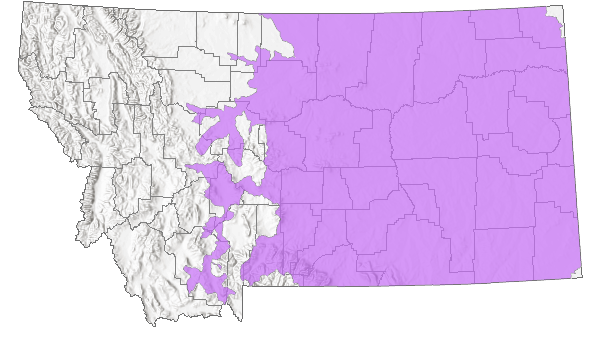
 Native
Native
Western Hemisphere Range
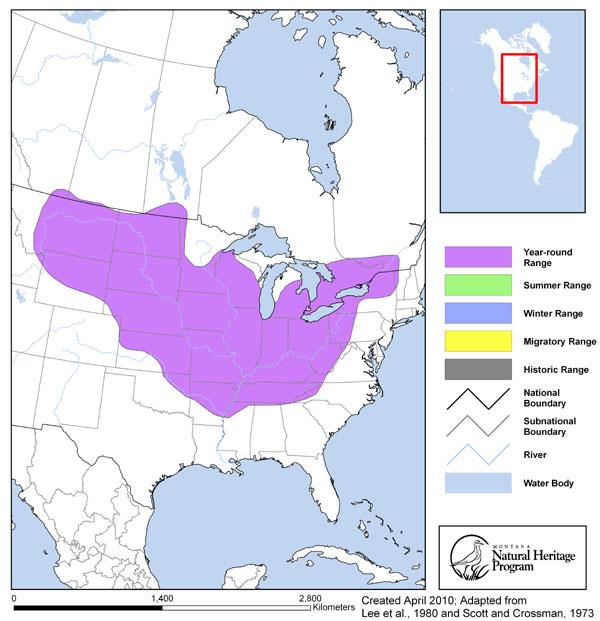
Range Comments
This species is widespread throughout all of eastern Montana rivers and is expanding it's range up colder trout rivers and streams that may be warming and more suitable for colonization (Madison, Smith, Missouri Rivers)
Observations in Montana Natural Heritage Program Database
Number of Observations: 1131
(Click on the following maps and charts to see full sized version)
Map Help and Descriptions
Relative Density
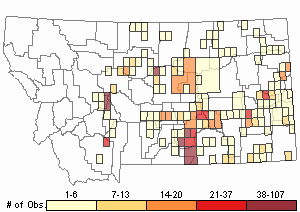
Recency
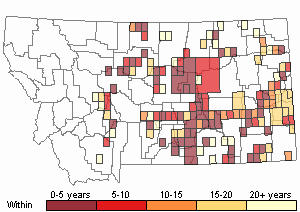

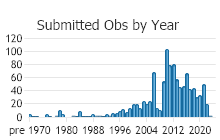
 (Observations spanning multiple months or years are excluded from time charts)
(Observations spanning multiple months or years are excluded from time charts)
Habitat
Swift-water areas of streams among rocks or under logs; also lakes over sand and gravel bottom where there is wave action. Found mainly in flowing water over rocky substrates in lower Yellowstone River drainage study. Also found in riffle habitat in middle Missouri River study.
Food Habits
Largely aquatic insects and small fish. Known to eat spawn of other fishes.
Ecology
Probably an important benthic insect eater in large rivers and may be a prey fish for nocturnal predators such as walleye and sauger, or large brown trout in cool water systems.
Reproductive Characteristics
Spawns June - Aug. in moderate current. Incubation: 1 - 2 weeks. Young guarded by parents. Spawning peaks late June.
Stewardship Responsibility
References
- Literature Cited AboveLegend:
 View Online Publication
View Online Publication Lee, D.S., C.R. Gilbert, C.H. Hocutt, R.E. Jenkins, D. E. McAllister, J. R. Stauffer, Jr. 1980. Atlas of North American freshwater fishes. North Carolina State Musuem of Natural History. 867 p.
Lee, D.S., C.R. Gilbert, C.H. Hocutt, R.E. Jenkins, D. E. McAllister, J. R. Stauffer, Jr. 1980. Atlas of North American freshwater fishes. North Carolina State Musuem of Natural History. 867 p. Scott, W.B. and E.J. Crossman. 1973. Rainbow trout, Kamloops trout, Steelhead trout Salmo gairdneri Richardson. pp. 184-191. In: Freshwater fishes of Canada. Ottawa, Canada: Fisheries Research Board of Canada, Bulletin 184. 966 p.
Scott, W.B. and E.J. Crossman. 1973. Rainbow trout, Kamloops trout, Steelhead trout Salmo gairdneri Richardson. pp. 184-191. In: Freshwater fishes of Canada. Ottawa, Canada: Fisheries Research Board of Canada, Bulletin 184. 966 p.
- Additional ReferencesLegend:
 View Online Publication
View Online Publication
Do you know of a citation we're missing? Barfoot, C.A. 1993. Longitudinal distribution of fishes and habitat in Little Beaver Creek, Montana. M.Sc. Thesis. Bozeman, MT: Montana State University. 66 p.
Barfoot, C.A. 1993. Longitudinal distribution of fishes and habitat in Little Beaver Creek, Montana. M.Sc. Thesis. Bozeman, MT: Montana State University. 66 p. Barfoot, C.A. and R.G. White. 1999. Fish assemblages and habitat relationships in a small northern Great Plains stream. The Prairie Naturalist 31(2):87-107.
Barfoot, C.A. and R.G. White. 1999. Fish assemblages and habitat relationships in a small northern Great Plains stream. The Prairie Naturalist 31(2):87-107. Clancey, C.G. 1978. The fish and aquatic invertebrates in Sarpy Creek, Montana. M.Sc. Thesis. Bozeman, MT: Montana State University. 54 p.
Clancey, C.G. 1978. The fish and aquatic invertebrates in Sarpy Creek, Montana. M.Sc. Thesis. Bozeman, MT: Montana State University. 54 p. Dieterman, D.J., M.P. Ruggles, M.L. Wildhaber, and D.L. Galat (eds). 1996. Population structure and habitat use of benthic fishes along the Missouri and Lower Yellowstone Rivers. 1996 Annual report of Missouri River Benthic Fish Study PD-95-5832 to U.S. Army Corps of Engineers and U.S. Bureau of Reclamation. 238 p.
Dieterman, D.J., M.P. Ruggles, M.L. Wildhaber, and D.L. Galat (eds). 1996. Population structure and habitat use of benthic fishes along the Missouri and Lower Yellowstone Rivers. 1996 Annual report of Missouri River Benthic Fish Study PD-95-5832 to U.S. Army Corps of Engineers and U.S. Bureau of Reclamation. 238 p. Duncan, M.B. 2019. Distributions, abundances, and movements of small, nongame fishes in a large Great Plains river network. Ph.D. Dissertation. Bozeman, MT: Montana State University. 255 p.
Duncan, M.B. 2019. Distributions, abundances, and movements of small, nongame fishes in a large Great Plains river network. Ph.D. Dissertation. Bozeman, MT: Montana State University. 255 p. Hendricks, P., S. Lenard, D.M. Stagliano, and B.A. Maxell. 2013. Baseline nongame wildlife surveys on the Fort Peck Indian Reservation. Report to the Assiniboine and Sioux Tribes of the Fort Peck Indian Reservation. Montana Natural Heritage Program, Helena, MT. 83 p.
Hendricks, P., S. Lenard, D.M. Stagliano, and B.A. Maxell. 2013. Baseline nongame wildlife surveys on the Fort Peck Indian Reservation. Report to the Assiniboine and Sioux Tribes of the Fort Peck Indian Reservation. Montana Natural Heritage Program, Helena, MT. 83 p. Joslin, Gayle, and Heidi B. Youmans. 1999. Effects of recreation on Rocky Mountain wildlife: a review for Montana. [Montana]: Montana Chapter of the Wildlife Society.
Joslin, Gayle, and Heidi B. Youmans. 1999. Effects of recreation on Rocky Mountain wildlife: a review for Montana. [Montana]: Montana Chapter of the Wildlife Society. Lance, M.J. 2019. Spatial and temporal variability in movements and vital rates of sympatric salmonids in an unfragmented, inland watershed. M.Sc. Thesis. Bozeman, MT: Montana State University. 116 p.
Lance, M.J. 2019. Spatial and temporal variability in movements and vital rates of sympatric salmonids in an unfragmented, inland watershed. M.Sc. Thesis. Bozeman, MT: Montana State University. 116 p. Montana Fish, Wildlife and Parks. 1989. Hauser Reservoir fisheries management plan: September 1989-September 1994. 16 p.
Montana Fish, Wildlife and Parks. 1989. Hauser Reservoir fisheries management plan: September 1989-September 1994. 16 p. Mullen, J.A. 2007. Spatiotemporal variation of fish assemblages in Montana prairie streams. M.Sc. Thesis. Bozeman, MT: Montana State University. 102 p.
Mullen, J.A. 2007. Spatiotemporal variation of fish assemblages in Montana prairie streams. M.Sc. Thesis. Bozeman, MT: Montana State University. 102 p. Mullins, M.S. 1991. Biology and predator use of cisco (Coregonus artedi) in Fort Peck Reservoir, Montana. M.Sc. Thesis. Bozeman, MT: Montana State University. 68 p.
Mullins, M.S. 1991. Biology and predator use of cisco (Coregonus artedi) in Fort Peck Reservoir, Montana. M.Sc. Thesis. Bozeman, MT: Montana State University. 68 p. Penkal, R.F. 1977. Black bass populations of the Tongue River Reservoir, Montana. M.Sc. Thesis. Bozeman, MT: Montana State University. 111 p.
Penkal, R.F. 1977. Black bass populations of the Tongue River Reservoir, Montana. M.Sc. Thesis. Bozeman, MT: Montana State University. 111 p. Pierce, B.E. 1963. Distribution of fish in a small mountain stream in relation to temperature. M.Sc. Thesis. Bozeman, MT: Montana State University. 16 p.
Pierce, B.E. 1963. Distribution of fish in a small mountain stream in relation to temperature. M.Sc. Thesis. Bozeman, MT: Montana State University. 16 p. Rosenthal, L.R. 2007. Evaluation of distribution and fish passage in relation to road culverts in two eastern Montana prairie streams. M.Sc. Thesis. Bozeman, MT: Montana State University. 78 p.
Rosenthal, L.R. 2007. Evaluation of distribution and fish passage in relation to road culverts in two eastern Montana prairie streams. M.Sc. Thesis. Bozeman, MT: Montana State University. 78 p. Stash, S.W. 2001. Distribution, relative abundance, and habitat associations of Milk River fishes related to irrigation diversion dams. M.Sc. Thesis. Bozeman, MT: Montana State University. 82 p.
Stash, S.W. 2001. Distribution, relative abundance, and habitat associations of Milk River fishes related to irrigation diversion dams. M.Sc. Thesis. Bozeman, MT: Montana State University. 82 p. Stringer, A.L. 2018. Status of Northern Pearl Dace and chrosomid dace in prairie streams of Montana. M.Sc. Thesis. Bozeman, MT: Montana State University. 150 p.
Stringer, A.L. 2018. Status of Northern Pearl Dace and chrosomid dace in prairie streams of Montana. M.Sc. Thesis. Bozeman, MT: Montana State University. 150 p. Sundeen, D.R. 1968. Abundance and movement of young trout in a portion of the Madison River, Montana. M.Sc. Thesis. Bozeman, Montana: Montana State University. 19 p.
Sundeen, D.R. 1968. Abundance and movement of young trout in a portion of the Madison River, Montana. M.Sc. Thesis. Bozeman, Montana: Montana State University. 19 p. Trenka, R.J. 2000. Community structure and habitat associations of fishes of the lower Tongue and Powder Rivers. M.Sc. Thesis. Bozeman, MT: Montana State University. 85 p.
Trenka, R.J. 2000. Community structure and habitat associations of fishes of the lower Tongue and Powder Rivers. M.Sc. Thesis. Bozeman, MT: Montana State University. 85 p. USDI Bureau of Land Management. No date. Fishes of the Miles city, Montana BLM District. Miles City, MT: Miles City BLM District pamphlet. 12 p.
USDI Bureau of Land Management. No date. Fishes of the Miles city, Montana BLM District. Miles City, MT: Miles City BLM District pamphlet. 12 p. Wuellner, M.R. 2007. Influence of reach and watershed characteristics on fish distributions in small streams of eastern Montana. M.Sc. Thesis. Bozeman, MT: Montana State University. 80 p.
Wuellner, M.R. 2007. Influence of reach and watershed characteristics on fish distributions in small streams of eastern Montana. M.Sc. Thesis. Bozeman, MT: Montana State University. 80 p. Young, B.A., T.L. Welker, M.L. Wildhaber, C.R. Berry, and D. Scarnecchia (eds). 1997. Population structure and habitat use of benthic fishes along the Missouri and Lower Yellowstone Rivers. 1997 Annual report of Missouri River Benthic Fish Study PD-95-5832 to U.S. Army Corps of Engineers and U.S. Bureau of Reclamation. 207 p.
Young, B.A., T.L. Welker, M.L. Wildhaber, C.R. Berry, and D. Scarnecchia (eds). 1997. Population structure and habitat use of benthic fishes along the Missouri and Lower Yellowstone Rivers. 1997 Annual report of Missouri River Benthic Fish Study PD-95-5832 to U.S. Army Corps of Engineers and U.S. Bureau of Reclamation. 207 p.
- Web Search Engines for Articles on "Stonecat"
- Additional Sources of Information Related to "Fish"





